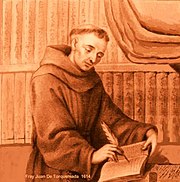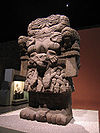Portal:Mesoamerica
Mesoamerica (Spanish: Mesoamérica) is a region and cultural area in the Americas, extending approximately from central Mexico to Belize, Guatemala, El Salvador, Honduras, Nicaragua, and Costa Rica, within which a number of pre-Columbian societies flourished before the Spanish colonization of the Americas in the 15th and 16th centuries.
As a cultural area, Mesoamerica is defined by a mosaic of cultural traits developed and shared by its indigenous cultures. Beginning as early as 7000 BC the domestication of maize, beans, squash and chili, as well as the turkey and dog, caused a transition from paleo-Indian hunter-gatherer tribal grouping to the organization of sedentary agricultural villages. In the subsequent formative period, agriculture and cultural traits such as a complex mythological and religious tradition, a vigesimal numeric system, and a complex calendric system, a tradition of ball playing, and a distinct architectural style, were diffused through the area. Also in this period villages began to become socially stratified and develop into chiefdoms with the development of large ceremonial centers, interconnected by a network of trade routes for the exchange of luxury goods such as obsidian, jade, cacao, cinnabar, Spondylus shells, hematite, and ceramics. While Mesoamerican civilization did know of the wheel and basic metallurgy, neither of these technologies became culturally important.
Among the earliest complex civilizations was the Olmec culture which inhabited the Gulf coast of Mexico. In the Preclassic period, complex urban polities began to develop among the Maya and the Zapotecs. During this period the first true Mesoamerican writing systems were developed in the Epi-Olmec and the Zapotec cultures, and the Mesoamerican writing tradition reached its height in the Classic Maya Hieroglyphic script. Mesoamerica is one of only five regions of the world where writing was independently developed. In Central Mexico, the height of the Classic period saw the ascendancy of the city of Teotihuacan, which formed a military and commercial empire whose political influence stretched south into the Maya area and northward. During the Epi-Classic period the Nahua peoples began moving south into Mesoamerica from the North. During the early post-Classic period Central Mexico was dominated by the Toltec culture, Oaxaca by the Mixtec, and the lowland Maya area had important centers at Chichén Itzá and Mayapán. Towards the end of the post-Classic period the Aztecs of Central Mexico built a tributary empire covering most of central Mesoamerica.
Selected article

Olmec colossal heads are a distinctive feature of the Olmec civilization of ancient Mesoamerica. The first archaeological investigations of Olmec culture were carried out by Matthew Stirling at Tres Zapotes in 1938, owing to the discovery there of a colossal head in the 19th century. Seventeen confirmed examples of stone heads are known, all from within the Olmec heartland on the Gulf Coast of Mexico, in the states of Veracruz and Tabasco. Most colossal heads were sculpted from spherical boulders but two from San Lorenzo Tenochtitlán were recarved from massive stone thrones. An additional monument, at Takalik Abaj in Guatemala, is a throne that may have been carved from a colossal head. This is the only known example outside of the Olmec heartland.
Dating of the monuments has proven difficult due to the movement of many from their original context. Most of the heads have been dated to the Early Preclassic (1500-1000 BC) and some to the Middle Preclassic (1000-400 BC). The smallest examples weigh 6 tons, while the largest is variously estimated to weigh 40 to 50 tons, although this was abandoned unfinished near to its quarry.
Olmec colossal heads were sculpted from large basalt boulders quarried in the Sierra de los Tuxtlas mountains of Veracruz. They were transported over large distances, although the method used for transportation is not clear. Finished momuments represented lifelike portraits of individual Olmec rulers, each wearing a distinctive headdress, and heads were variously arranged in lines or groups at major Olmec centres.
Selected biography

Juan de Torquemada (c. 1562 – 1624) was a Franciscan friar, missionary and historian in Spanish colonial Mexico, and is considered the "leading Franciscan chronicler of his generation." He is most famous for his monumental history of the indigenous peoples entitled Los veinte y un libros rituales y Monarquía indiana, commonly known as Monarquía indiana ("Indian Monarchy"), published initially in Spain in 1615 with a license obtained by Torquemada. Monarquia Indiana was the "prime text of Mexican history, and was destined to influence all subsequent chronicles until the twentieth century." The fact that it was republished a century later in 1723, in what has been considered the standard edition, is an indication of its importance. It was used by later historians, the Franciscan Augustin de Vetancurt and most importantly by eighteenth-century Jesuit Francisco Javier Clavijero.
Juan de Torquemada was born at Torquemada, Palencia, sometime between 1557 and 1565, with few firm data on his life, with much coming from his own work. He arrived in New Spain as a child and grew up in Mexico City. He studied philosophy and Nahuatl at the convent Grande de San Francisco in Mexico City, studying under Fray Juan Bautista and Antonio de Valeriano, an indigenous graduate of the colegio who taught him Nahuatl. He was ordained sometime between 1579 and 1583. In 1582 he moved to the convent of Santiago Tlatelolco, and he was made guardian of that convent in 1600. He also took over the administration of the Colegio de Santa Cruz de Tlatelolco.
Did you know?
- ...that after the Aztec Coatlicue statue (pictured) was discovered, it was buried again to prevent it becoming the object of a cult?
- ... that the K'iche' kingdom of Q'umarkaj in Central America was conquered when the Kaqchikel people allied with a Spanish force?
Subcategories
Related portals
Selected image
 |
Xipe Totec ("our lord the flayed one") was a life-death-rebirth deity, god of agriculture, vegetation, the east, disease, spring, goldsmiths, silversmiths and the seasons. Xipe Totec flayed himself to give food to humanity, symbolic of the way maize seeds lose their outer layer before germination and of snakes shedding their skin.
Featured articles
Good Topics
Good articles
 Gómez de Alvarado
Gómez de Alvarado Aztecs
Aztecs La Blanca, Peten
La Blanca, Peten Calakmul
Calakmul Bartolomé de las Casas
Bartolomé de las Casas Copán
Copán El Chal
El Chal Haʼ Kʼin Xook
Haʼ Kʼin Xook Itzam Kʼan Ahk II
Itzam Kʼan Ahk II Iximche
Iximche Kʼinich Yat Ahk II
Kʼinich Yat Ahk II Kʼinich Yoʼnal Ahk I
Kʼinich Yoʼnal Ahk I Macuahuitl
Macuahuitl Maize
Maize Manche Chʼol
Manche Chʼol Mixco Viejo
Mixco Viejo Motul de San José
Motul de San José Mundo Perdido, Tikal
Mundo Perdido, Tikal North Acropolis, Tikal
North Acropolis, Tikal Potbelly sculpture
Potbelly sculpture William H. Prescott
William H. Prescott Qʼumarkaj
Qʼumarkaj Resplendent quetzal
Resplendent quetzal Seibal
Seibal Serpent labret with articulated tongue
Serpent labret with articulated tongue Spanish conquest of Yucatán
Spanish conquest of Yucatán Spanish conquest of Chiapas
Spanish conquest of Chiapas Spanish conquest of El Salvador
Spanish conquest of El Salvador Spanish conquest of Honduras
Spanish conquest of Honduras Spanish conquest of the Maya
Spanish conquest of the Maya Tikal
Tikal Toniná
Toniná Western Mexico shaft tomb tradition
Western Mexico shaft tomb tradition Benjamin Lee Whorf
Benjamin Lee Whorf Yoʼnal Ahk III
Yoʼnal Ahk III Zaculeu
Zaculeu
Topics
WikiProjects
New articles
Rules | Match log | Results page (for watching) | Last updated: 2024-04-19 09:11 (UTC)
Note: The list display can now be customized by each user. See List display personalization for details.
- Carpotroche caceresiae (edit | talk | history | links | watch | logs | tools) by Jillian2972 (talk · contribs · new pages (2)) started on 2024-04-15, score: 24
- Transgender archaeology (edit | talk | history | links | watch | logs | tools) by Lajmmoore (talk · contribs · new pages (19)) started on 2024-04-13, score: 32
- Playa del Carmen railway station (edit | talk | history | links | watch | logs | tools) by SleepTrain456 (talk · contribs · new pages (10)) started on 2024-04-12, score: 60
- Vasco Porcallo de Figueroa (edit | talk | history | links | watch | logs | tools) by Dokyundokyundokyun (talk · contribs · new pages (1)) started on 2024-04-12, score: 24
- Tenejapa-Lacandón Formation (edit | talk | history | links | watch | logs | tools) by Geekgecko (talk · contribs · new pages (19)) started on 2024-04-12, score: 88
- Maya Bhatia (edit | talk | history | links | watch | logs | tools) by 104.158.5.175 (talk · contribs · new pages (2)) started on 2024-04-11, score: 24
- Convention on Diplomatic Asylum (edit | talk | history | links | watch | logs | tools) by Andrew Davidson (talk · contribs · new pages (4)) started on 2024-04-07, score: 48
- Eclipses in history and culture (edit | talk | history | links | watch | logs | tools) by Dan Leonard (talk · contribs · new pages (9)) started on 2024-04-06, score: 26
Associated Wikimedia
The following Wikimedia Foundation sister projects provide more on this subject:
-
Commons
Free media repository -
Wikibooks
Free textbooks and manuals -
Wikidata
Free knowledge base -
Wikinews
Free-content news -
Wikiquote
Collection of quotations -
Wikisource
Free-content library -
Wikiversity
Free learning tools -
Wiktionary
Dictionary and thesaurus

























